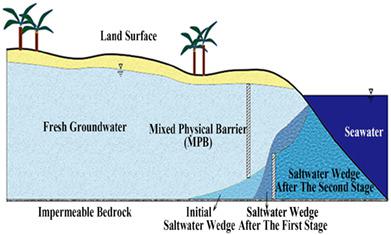当前位置:
X-MOL 学术
›
Hydrol. Process.
›
论文详情
Our official English website, www.x-mol.net, welcomes your feedback! (Note: you will need to create a separate account there.)
Effects of mixed physical barrier on residual saltwater removal and groundwater discharge in coastal aquifers
Hydrological Processes ( IF 3.2 ) Pub Date : 2021-06-03 , DOI: 10.1002/hyp.14263 Mingpeng Gao 1, 2 , Tianyuan Zheng 3 , Qinpeng Chang 1, 2 , Xilai Zheng 1, 2 , Marc Walther 4
Hydrological Processes ( IF 3.2 ) Pub Date : 2021-06-03 , DOI: 10.1002/hyp.14263 Mingpeng Gao 1, 2 , Tianyuan Zheng 3 , Qinpeng Chang 1, 2 , Xilai Zheng 1, 2 , Marc Walther 4
Affiliation

|
Physical barriers are widely used to control seawater intrusion (SWI). Amongst different kinds of physical barriers, mixed physical barriers (MPBs) are shown to be an effective approach to prevent SWI. However, the system may hinder the discharge of fresh groundwater and the removal of residual saltwater trapped in the inland aquifers of MPBs. Herein, using the validated numerical model, for the first time, we investigated the dynamics of residual saltwater and groundwater discharge after the installation of MPBs. For examining the applicability of MPB and its response to structural variations and hydraulic gradient, the comparison with traditional physical barriers and sensitivity analysis was also carried out. The MPB increased the mixing area of freshwater and saltwater at the beginning of the removal process, resulting in the reduction of the saltwater wedge length (RL) by 74.6% and the removal of total salt mass (RM) by 62.6% within the 4% of the total removal time. Meanwhile, the groundwater discharge (Q') rose rapidly after a sharp decline from 100% to 40% in the first stage. As the residual saltwater wedge was retreated, the mixing intensity and removal efficiency decreased substantially in the second stage. Similarly, Q' raised with a declining rate at this stage. The removal efficiency was positively correlated with wall depth and hydraulic gradient and there were optimal distance of the middle spacing and height of lower dam to reach the highest efficiency. The groundwater discharge reduced monotonously with the increase of dam height and wall depth as well as the decrease of barrier spacing and hydraulic gradient. Under certain conditions, the efficiency of MPB in removing residual saltwater could be 40%–100% and 0%–56% higher than that of traditional subsurface dam and cutoff wall, respectively. The laboratory scale conclusions provide valuable physical insight for the real field applications regarding dynamic mechanism and regularity. These findings will always help decision makers choose proper engineering measures and protect groundwater resources in coastal areas.
中文翻译:

混合物理屏障对沿海含水层残余盐水去除和地下水排放的影响
物理屏障被广泛用于控制海水入侵(SWI)。在不同种类的物理屏障中,混合物理屏障 (MPB) 被证明是预防 SWI 的有效方法。然而,该系统可能会阻碍新鲜地下水的排放和去除 MPB 内陆含水层中残留的盐水。在此,我们首次使用经过验证的数值模型研究了安装 MPB 后残余盐水和地下水排放的动态。为了检验 MPB 的适用性及其对结构变化和水力梯度的响应,还进行了与传统物理屏障的比较和敏感性分析。MPB 在去除过程开始时增加了淡水和咸水的混合面积,在总去除时间的 4% 内,R L ) 减少了 74.6%,总盐质量 ( R M ) 去除了 62.6%。同时,地下水排放量(Q')在第一阶段从100%急剧下降到40%后迅速上升。随着残留盐水楔的再处理,第二阶段的混合强度和去除效率大幅下降。同样,Q'在这个阶段以下降的速度上升。清除效率与墙深和水力坡度呈正相关,下坝中间间距和高度存在最佳距离,以达到最高效率。地下水流量随着坝高和墙深的增加以及屏障间距和水力梯度的减小而单调减少。在一定条件下,MPB去除残余盐水的效率比传统的地下坝和防渗墙分别提高40%~100%和0%~56%。实验室规模的结论为有关动态机制和规律性的实际现场应用提供了有价值的物理见解。
更新日期:2021-07-06
中文翻译:

混合物理屏障对沿海含水层残余盐水去除和地下水排放的影响
物理屏障被广泛用于控制海水入侵(SWI)。在不同种类的物理屏障中,混合物理屏障 (MPB) 被证明是预防 SWI 的有效方法。然而,该系统可能会阻碍新鲜地下水的排放和去除 MPB 内陆含水层中残留的盐水。在此,我们首次使用经过验证的数值模型研究了安装 MPB 后残余盐水和地下水排放的动态。为了检验 MPB 的适用性及其对结构变化和水力梯度的响应,还进行了与传统物理屏障的比较和敏感性分析。MPB 在去除过程开始时增加了淡水和咸水的混合面积,在总去除时间的 4% 内,R L ) 减少了 74.6%,总盐质量 ( R M ) 去除了 62.6%。同时,地下水排放量(Q')在第一阶段从100%急剧下降到40%后迅速上升。随着残留盐水楔的再处理,第二阶段的混合强度和去除效率大幅下降。同样,Q'在这个阶段以下降的速度上升。清除效率与墙深和水力坡度呈正相关,下坝中间间距和高度存在最佳距离,以达到最高效率。地下水流量随着坝高和墙深的增加以及屏障间距和水力梯度的减小而单调减少。在一定条件下,MPB去除残余盐水的效率比传统的地下坝和防渗墙分别提高40%~100%和0%~56%。实验室规模的结论为有关动态机制和规律性的实际现场应用提供了有价值的物理见解。



























 京公网安备 11010802027423号
京公网安备 11010802027423号